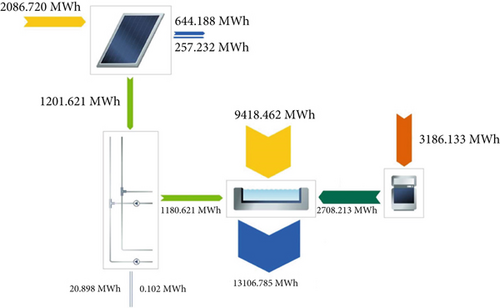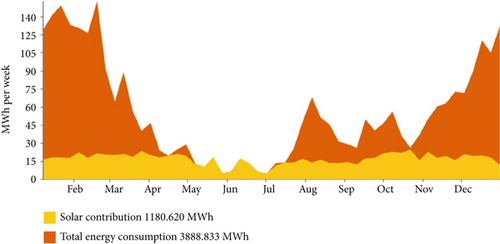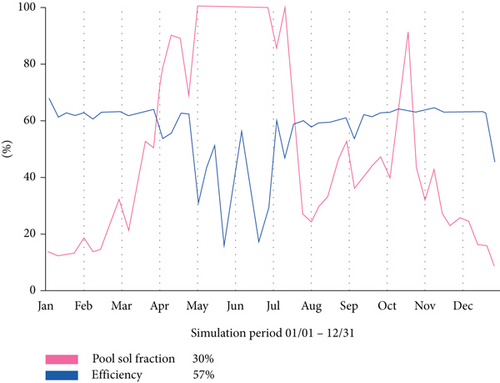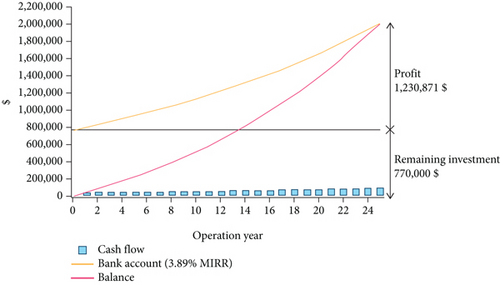Harnessing Solar Power for Eco- and Enviro-Friendly Water Park Heating: Case Study of Hawana Water Park
Abstract
In this study, the feasibility of providing part of the hot water using 1000 flat-plate solar collectors for the Hawana Water Park in Salalah, Oman, is studied. Dynamic analyses of energy, economic, and environmental parameters are conducted over a year using TSOL V2021 software. In this solar energy–supported hot water production system, a gas-fired boiler is also used as a backup for emergencies. The results indicate that approximately 1181 MWh of solar heat is supplied annually to the water park, leading to a savings of 133,298 m3 of natural gas and preventing the emission of approximately 282 tons of CO₂ pollutants. Another significant finding is that the solar water heating system, with an efficiency of 56.6%, was able to supply 30.4% of the heat required by the water park. The cost of each kilowatt-hour of solar heat produced is calculated to be $0.066, with a payback period of 15.2 years. Furthermore, eight sensitivity scenarios were evaluated to investigate the impact of carbon credit trading and energy price increases on the economic performance of the assessed system. The results indicate that by integrating carbon pricing mechanisms, such as the Emissions Trading System (ETS), the cost of energy (COE) can be reduced by up to $0.026 per kWh, and the payback period can be shortened to 8.4 years. Moreover, the return on assets (ROA) significantly improves under scenarios involving higher carbon credit prices and rising energy costs, highlighting the economic and environmental benefits of integrating renewable energy systems with emerging carbon markets.
1. Introduction
In the modern world, energy is essential for economic growth, societal welfare, and security [1]. However, the heavy reliance on fossil fuels, which are both polluting and finite, has created significant challenges, and still, around 90% of the world’s energy is supplied by these fuels [2]. The shift toward clean alternative sources, such as renewable energies, is key to achieving a sustainable and secure future [3]. This requires a collective effort to reduce dependence on fossil fuels and to develop renewable energy sources [4]. Advances in the utilization of solar energy have significantly increased its share among renewable energies [5]. Solar energy applications range from power generation to nonpower applications such as SWH, space heating, solar cooling, water desalination, and electricity generation—just a few examples of the diverse uses of solar energy. Among these, SWH systems hold a special position due to their simplicity, cost-effectiveness, and environmental benefits [6]. SWH systems are among the most widely used methods for easy and general utilization of solar energy for hot water supply in both residential and industrial scales [7]. These systems are favored for their simple structure, design flexibility, and ability to be installed in confined spaces like building rooftops [8].
Using SWH systems to provide hot water in homes, industrial sites, and public facilities is considered one of the most practical and economical methods of utilizing renewable resources due to its simple technology [9]. The widespread adoption of SWH systems can significantly reduce the predictable energy consumption for heating water in homes, commercial units, and other facilities [10].
An SWH system consists of several components, including a solar collector, heat exchanger, heat transfer fluid, storage tank, circulation pumps, and flow control valves [11]. During the day, the solar collector absorbs the sun’s energy and transfers it to the heat transfer fluid. The heated fluid is then transferred to a storage tank where it is stored. When hot water is needed, cold water is directed from the tank to the heat exchanger, where it receives heat from the heat transfer fluid. Various heat transfer fluids, such as air, hydrocarbon oils, and glycol/water mixtures, are used in SWH systems, but water is the most commonly used fluid in these systems [12].
Oman relies heavily on fossil fuels for its energy needs due to its abundant fossil fuel reserves. This dependency leads to the production of 70.5 million tons of CO2 annually, which is a significant amount. However, policies and investments indicate that Oman is moving toward utilizing sustainable energy to mitigate climate change [13].
Table 1 shows the various studies conducted on the use of solar energy utilization to provide a portion of the hot water needs.
| Reference | Year | Location | Methodology | Purpose | Result | Different with present work |
|---|---|---|---|---|---|---|
| [14] | 2021 | Zambia | TSOL Pro 5.5 | Determining the best station among 22 cities to use SWH systems and modeling the reduction of greenhouse gas emissions | The three cities of Kabwe, Chipata and Mbala had the highest reduction rates of greenhouse gases |
|
| [15] | 2022 | Shahrekord, Iran | TSOL Pro 5.5 | Supplying space heating, sanitary hot water, and swimming pool hot water for a residential apartment | Heat supply in the high solar fraction scenario, the percentage of solar heat supply for sanitary hot water, space heating and swimming pool is 97.8%, 22.3%, and 44.3%, respectively |
|
| [16] | 2022 | El Gouna, Egypt | TSOL Pro 5.5 | Technical–economic feasibility of SWHs for swimming pools in hotels and tourist resorts | The installed collector power of the proposed SWHS system is 9.980 MW and the share of solar energy in the swimming pool is 25.831 MWh |
|
| [17] | 2023 | Iran | TSOL Pro 5.5 | Feasibility of producing part of the required heat of a residential building with a swimming pool and sanitary water in 4 different climates in Iran | For all four investigated climates, the combined system of tanks performs better |
|
| [18] | 2023 | Egypt | TSOL Pro 5.5 | Determine the best station among 35 different stations to use SWH | Sharm El-Sheikh station is the best station for using SWH systems, providing 96.8% of its total heat requirement |
|
| [19] | 2024 | Jordan | Polysunand TSOL | Investigating the use of solar thermal energy systems in poultry slaughterhouses | The system based on the SWH provides approximately 72% of the annual energy requirement and leads to the saving of 1926.396 MWh of energy |
|
| [20] | 2024 | Oman | Mathematical technique and MATLAB | Evaluation of the use of SWHs in 11 provinces to investigate the environmental and financial benefits | Providing the proposed plan leads to annual savings of up to 106.03 $ and 927.01 kg of CO2 in Muscat |
|
| [21] | 2023 | Kirkuk, Iraq | TSOL Pro 5 | Evaluation of the use of domestic water heaters (DWH) and its integration with SWH systems in private residences located in Kirkuk, Iraq. | Using the proposed systems provides 86% of the required 1.430 MWh of energy and prevents the emission of 689.5 to 1316 kg of CO2 annually. |
|
| [4] | 2023 | Yazd, Iran | TSOL Pro 5.5 | Evaluation of the use of SWHs in a hospital located in Yazd | The proposed system for providing internal heating and hot water can prevent the annual emission of 630 kg of pollutants and provide the equivalent of 26.5% of 7.320 MWh of total energy required | - Using SWH systems for space heating and sanitary consumption |
| [22] | 2023 | Kuujjuaq, Canada | MATLAB and TRNSYS | Investigating the technical-economical–environmental performance of flat-plate, evacuated tube, and photovoltaic SWH systems | Despite the low efficiency of photovoltaic water heaters, they are technically and economically more efficient than other systems. But during their life cycle, they produce three times more CO2 than fossil fuel water heaters |
|
| [23] | 2023 | Wuhan, China | TRNSYS | Feasibility of domestic gas boiler heating system coupled with solar heating system in both parallel and series ways | The proposed system is economically superior to the gas boiler system. The parallel coupler of the proposed system has a solar fraction of 24.4% and a return on investment (ROI) of 4.75 years |
|
| Present work | 2025 | Salalah, Oman | TSOL V2021 | Feasibility of using the SWH system on a large scale to supply the hot water needed by Hawana aqua park, taking into account the temperature effects | The investigated system produces about 30.4% of the water park’s hot water requirement and prevents the emission of 282 tons of CO2 annually. The ROI in this system is about 15.2 years | — |
Although research on SWH systems has grown significantly in recent years, few studies have specifically focused on providing the required hot water for swimming pools and water parks. Given that water parks have substantial hot water needs, this study addresses this topic. Moreover, while TSOL software is generally used for simulating SWH systems at a small or residential scale, this study applies it on a large scale.
This study is aimed at investigating the feasibility of using SWH systems to meet the hot water needs of the Hawana Water Park located in Salalah, the largest city and the capital of the Dhofar Governorate in southern Oman. According to the research conducted, the feasibility of using SWH systems to supply a portion of the hot water needed by a water park has not been studied before. Previous studies have either focused on small, domestic settings, examined different climates, lacked swimming pools, or did not include economic analyses. In addition, the present study uniquely incorporates sensitivity analysis scenarios involving carbon credit trading and energy price escalation, which have not been addressed in previous works. This research addresses these gaps, providing results that can be valuable for decision-makers and investors in the solar energy sector.
The next sections discuss the study site, methodology, and required data for simulating the water park system, followed by numerical results and simulations, with key findings summarized as bullet points in the conclusion.
2. System and Methodology
Salalah, with a population of 454,535, is the third most populous city in Oman [24]. As shown in Figure 1, the city is located at the geographical coordinates of 17° 30 ′ N, 54° 80 ′ E. This geographical location grants Salalah a significant horizontal solar irradiance potential, varying between 2.337 and 2.483 MWh annually, as illustrated in Figure 2 [25]. Salalah has a warm-humid climate, with average temperatures ranging from 23°C to 29°C throughout the different months of the year. Due to monsoon rains during the summer, Salalah typically experiences a drop in temperature, setting it apart from other regions in Oman [26].


Hawana Water Park, located in Salalah and spanning over 65,000 m2, opened in 2017 [27]. With a daily capacity of 1500 visitors, this water park is considered one of the largest in the region [28]. Its convenient location near Salalah International Airport has facilitated access for both domestic and international tourists. This has made Hawana Water Park a popular destination for visitors [29].
T ∗SOL offers design and simulation capabilities for a wide range of solar thermal systems, including those for domestic hot water supply, space heating, swimming pool heating, process heat applications, and large-scale installations. The software enables high-fidelity, year-long simulations of solar thermal system performance, capturing dynamic system behavior [7].
After accounting for conversion efficiency and incident angle dependence, a fraction of the absorbed radiation is lost via conductive, convective, and radiative heat transfer to the surroundings. The heat transfer coefficient encompasses these combined losses.
The heat transfer coefficient (k) quantifies collector heat loss to the environment per unit area and temperature difference. Similarly, the specific heat capacity (Ws/m2K) reflects the collector’s thermal storage per unit area per unit temperature rise. This latter property mainly influences rapid response in systems with small piping networks.
These metrics assess the profitability and asset efficiency of the proposed SWH system for the water park.
To conduct the intended simulation, it is essential to collect climatic data, including the total solar radiation received at the Earth’s surface. Other required data include air temperature, water temperature in the piping network, and the geographical coordinates of the target location [34]. These data are extracted using the MeteoSyn software, which is installed simultaneously with TSOL [35]. The schematic of the system under study is shown in Figure 3.

Given the substantial amount of hot water required for the water park and the lack of spatial restrictions for installing collectors on the extensive area of the water park under study (65,000 m2, covering less than 2% of the area), the use of 1000 collectors offers several technical advantages. These include uniform heat distribution, which extends system lifetime, improved performance under various weather conditions, and increased hot water production capacity. This study’s results can be scaled easily for other locations with similar climates, providing a useful reference for energy sector decision-makers. Conversely, using fewer collectors would not meet the hot water requirements and would necessitate fossil fuels, while using more collectors would reduce the system’s net profitability and make it less economically viable.
Table 2 presents the specifications of the heating equipment used, as well as the details of the water park under study. As indicated, 1000 m2 of solar collectors with a 17° angle have been used to supply hot water, and a 1 MW gas-fired auxiliary boiler serves as a backup for the SWH system. Additionally, two heat exchangers are employed to facilitate heat exchange between the supply and return water circuits.
| Equipment | Specifications |
|---|---|
| Collector | Type: standard flat-plate |
| Conversion factors: 78% | |
| Heat transfer coefficients: 3.8 W/(m2K) | |
| Active solar surface: 1 m2 | |
| Specific heat capacity: 6 kJ/(m2K) | |
| Installation angle: 17° | |
| Azimuth: 180° | |
| Working fluid: 60% water and 40% propylene glycol | |
| Pool | Water flow rate: 40 L/h per collector m2 |
| Surface: 6500 m2 | |
| Mean depth: 1.5 m | |
| Desired temperature: 27°C | |
| Maximum swimming pool temperature: 30°C | |
| Daily fresh water requirement: 450 m3 | |
| Gas-fired boiler | Nominal output: 1 MW |
| Required energy source: natural gas (lower heating value: 37,512 kJ/m3, higher heating value: 41,112 kJ/m3) | |
| Heating efficiency: 85% based on lower heating value | |
| Piping | Length: 1000 m |
| Thermal conductivity of insulation: 0.045 W/(m.K) | |
| Nominal diameter: 168 mm (between collectors: 125 mm) | |
| Insulation thickness: 100% of pipe’s nominal diameter | |
| Distance between collectors: 200 mm | |
The selection of a 17° angle corresponds to the latitude of the site, ensuring that solar radiation hits the collectors perpendicularly, maximizing absorption [36].
Gas boilers were selected due to the high prevalence of natural gas in Oman, accounting for approximately 88% of the country’s total energy supply [37]. In addition, natural gas is a low-carbon alternative compared to other fossil fuels [38].
The propylene glycol–water mixture offers significant benefits compared to pure water. Due to its thermophysical properties, this mixture can enhance heat absorption and transfer, potentially increasing efficiency by up to 75% under specific conditions [39]. Furthermore, the use of this working fluid, accompanied by corrosion inhibitors, reduces corrosion within the system [40]. It is also noteworthy that propylene glycol poses a lower environmental and human health risk compared to ethylene glycol; its nontoxic nature makes it a more suitable choice for SWH systems, minimizing damage in case of leakage [41].
Solar collectors come in various types, with flat plate collectors and evacuated tube collectors being the most common for SWH systems. The choice of collector depends on factors such as the local climate, the required hot water temperature, and the estimated costs associated with the system. Table 3 compares the two types [42]:
| Flat plate collector | Evacuated tube collector |
|---|---|
| Suitable for warm to moderate climates | Suitable for cold to moderate climates |
| High physical durability | Lower durability and fragility |
| Lower initial cost | Higher initial cost |
| Easy and low-cost maintenance; more common in large-scale systems | Specialized and costly maintenance due to tube replacement requirements |
| Moderate efficiency (capable of heating water to 25–100°C) | High efficiency (capable of heating water to 50–200°C) |
Considering the climate of the study site—with hot summers and moderate winters [43]—as well as the system requirements, such as the desired hot water temperature of 27°C and a maximum of 30°C, and the need for cost-effectiveness in large-scale systems, flat plate collectors were selected for the proposed system.
Several scenarios regarding carbon credit sales and the potential increase in natural gas prices and their impacts on the proposed system have been analyzed in the present study. ETS and carbon taxes are among the policies that countries employ to combat pollution emissions such as CO₂. ETS has consistently been recognized as one of the most promising tools for reducing greenhouse gas emissions globally, offering significant advantages in terms of flexibility, cost savings, and efficiency. Under an ETS, a cap is set on total allowable emissions, compelling emitters to remain within their allocated limits. Over time, the cap is gradually reduced. A trading mechanism is established whereby industries requiring higher emission allowances can purchase credits from industries that emit less than their permitted limits [44].
Carbon taxes represent another approach to controlling emissions, wherein governments impose a direct fee on emitters based on the amount of CO₂ released. This method incentivizes emitters to reduce their carbon footprint and transition toward more eco-friendly operations to lower their costs [45]. By 2024, a total of 75 countries had adopted either ETS or carbon taxation mechanisms. The lowest and highest carbon prices are reported in Indonesia ($0.61) and Uruguay ($167.17), respectively [46]. Oman is currently developing carbon emission frameworks and establishing a national carbon market [47]. Given the significant reduction in carbon emissions achieved in this study, selling carbon credits could serve as an effective strategy to reduce overall costs and shorten the system’s payback period.
3. Results and Discussion
According to the results shown in Figure 4, the highest energy loss is due to the heat dissipation from the pool water to the surrounding environment, amounting to approximately 13,107 MWh annually. Optical losses, totaling around 644 MWh, rank second in system losses, followed by thermal losses from the collectors at approximately 257 MWh. Heat loss from the external piping, at about 21 MWh, ranks fourth, and internal piping thermal losses, which are negligible, rank fifth in the system’s total heat losses. The pool receives 1181 MWh of solar heat through the solar collectors and about 9418 MWh of direct solar radiation. Additionally, the gas-fired boiler produces approximately 2708 MWh of auxiliary heat and is supplied to the pool throughout the year.

By calculating the net energy produced by the solar collectors using Equation (1), Equation (2) can be used to determine what fraction of the total required energy is supplied by the solar collectors. Based on Figure 5, out of the total 3888.833 MWh of heat required by the water park’s swimming pool, 1180.620 MWh is supplied by the SWHs, resulting in a solar fraction of 30.4% for the SWHs. The results of Figure 5 indicate that in May, June, and the first half of July, the SWHs were able to fully meet the heat demand. This is due to the lower heating requirements during these months when the weather is warm. The greatest heating shortfall, corresponding to the highest reliance on the gas-fired boiler, occurs in December, January, and February. The maximum solar heat production, ranging between 15 and 30 MWh/week, is observed in October.

Based on the simulation output, the total annual solar radiation was 2.00745 MWh/m2, with the solar fraction and system efficiency estimated at 30.4% and 56.6%, respectively. As shown in Figure 6, it is noteworthy that although the highest solar fraction occurs in the middle months of the year, the lowest efficiency is also observed during this time. This is due to the warm weather and the reduced need for using the solar heating system.

The system utilized 1000 collectors, with a simulated capacity of 0.54727 MW. According to Figure 7, the energy absorbed by these collectors was measured at 1180.62 MWh/m2. Additionally, the annual energy supplied by the boiler was calculated at 2708.212 MWh. This translates to a savings of 133,298 m3 of natural gas for heating the pool water, thereby preventing the emission of 281,877.52 kg of CO2. According to Figure 8, the highest reduction in CO2 emissions occurred in October (30,000 kg), while the lowest reduction occurred in May (14,000 kg).


The cost of each kilowatt-hour of solar heat produced is calculated by dividing all annual costs incurred for heating by the amount of solar heat produced over the course of a year, as shown in (3). The simulation results indicate that the cost of each kilowatt of solar energy is $0.066, and the total cost of implementing the model is $770,000. Considering an interest rate of 6%, the net profit after deducting the total costs at the end of 25 years is measured at $1,230,871, as shown in Figure 9. The project’s payback period has been calculated to be 15.2 years.

The yellow line in Figure 9 represents the modified internal rate of return (MIRR), an indicator commonly used in financial analysis to measure the profitability of investment projects. By adjusting the traditional internal rate of return, MIRR provides a more accurate picture of a project’s actual return, thus improving investment decision-making.
Since payback depends on factors such as initial cost, operational cost, exchange rate, energy price, government incentives, revenue, and system lifespan, although the initial payback period is around 13 years, with interest rates and system depreciation accounted for, the true payback period is 15.2 years.
Since Oman does not currently have a direct carbon tax, its efforts to develop a carbon market and engage with Article 6 mechanisms indicate a clear move toward carbon pricing. Therefore, five different scenarios (Sc. Carbons 1–5) involving various carbon credit sale prices have been incorporated into the sensitivity analysis to more precisely assess their impact on total costs, payback period, and ROA. Considering the international carbon price range ($0.61–$167.17 per ton of CO₂), the sale prices adopted in these scenarios are $0.61 (lowest price), $42.25 (lower quartile), $83.89 (median), $125.53 (upper quartile), and $167.17 (highest price). Furthermore, to more accurately evaluate the effect of an annual increase in energy rates on the payback period and ROA, three additional scenarios (Sc. A–C) were incorporated into the analysis. In total, the eight aforementioned scenarios, along with the base scenario (Sc. Base), are summarized in Table 4.
| Scenarios | Energy escalation rate (%) | Carbon Price ($/tCO2) | Annual carbon revenue ($) | Total carbon revenue ($) | COE ($/kWh) | ROI (year) | ROA (%) |
|---|---|---|---|---|---|---|---|
| Sc. Base | 3 | 0 | 0 | 0 | 0.066 | 15.2 | 198.7 |
| Sc. A | 6 | 0 | 0 | 0 | 0.066 | 12.5 | 392.3 |
| Sc. B | 12 | 0 | 0 | 0 | 0.066 | 9.8 | 886.2 |
| Sc. C | 18 | 0 | 0 | 0 | 0.066 | 8.3 | 2371.6 |
| Sc. Carbon 1 | 3 | 0.61 | 171.95 | 4298.63 | 0.066 | 15.1 | 199.2 |
| Sc. Carbon 2 | 3 | 42.25 | 11,909.33 | 297,733.13 | 0.056 | 12.7 | 237.3 |
| Sc. Carbon 3 | 3 | 83.89 | 23,646.71 | 591,167.63 | 0.046 | 10.9 | 275.4 |
| Sc. Carbon 4 | 3 | 125.53 | 35,384.09 | 884,602.13 | 0.036 | 9.5 | 313.5 |
| Sc. Carbon 5 | 3 | 167.17 | 47,121.47 | 1,178,036.63 | 0.026 | 8.4 | 351.6 |
To better appreciate the importance of combating greenhouse gas emissions, it is worth noting that planting approximately 31–46 trees is required to offset the adverse effect of one ton of CO₂ emissions [48]. These findings support the adoption of complementary environmental policies in Oman, such as the development of carbon markets, to more rapidly achieve the economic feasibility of renewable energy systems.
4. Conclusion
- -
Annually, approximately 2087 MWh of solar radiation is incident on the examined collectors. After accounting for optical, thermal, and piping losses, about 1181 MWh of heat is transferred to the pool.
- -
Due to direct solar radiation incident on the pool surface, approximately 9418 MWh of solar heat is delivered directly to the pool each year.
- -
Annually, about 2708 MWh of heat is supplied by the auxiliary gas-fired boiler.
- -
The solar fraction provided by the SWHs for the water park is 30.4%.
- -
Savings in natural gas consumption and prevention of CO₂ emissions amount to 133,298 m3 and approximately 282 tons annually, respectively.
- -
During the warmer months (April to August), the system efficiency is significantly reduced due to the collector surface temperature exceeding 130°C at times.
- -
With an initial investment of $770,000, the cost per kilowatt-hour of produced solar heat and the payback period are calculated to be $0.066 and 15.2 years, respectively.
- -
At the end of the 25-year project lifetime, the net profit is $230,871.
- -
The analysis of various scenarios involving a range of carbon credit prices and different annual energy price escalation rates demonstrated that these external policy factors can have a significant impact on the project’s economic outcomes.
- -
Higher carbon prices and sharp increases in energy costs lead to a reduction in the payback period (down to 8.3 years) and a substantial rise in the ROA (up to 2371%), indicating the strong potential of these variables to enhance the investment attractiveness of the system.
The proposed SWH system offers a sustainable and efficient solution for meeting thermal needs in large-scale facilities. By combining solar collectors with a backup boiler, this system not only ensures a reliable supply of hot water but also significantly reduces dependency on fossil fuels. This approach lowers operational costs and helps protect the environment by reducing greenhouse gas emissions. The system’s ability to effectively harness solar energy demonstrates its potential to support the global transition to renewable energy sources. Additionally, its long-term economic viability and alignment with sustainable development goals make this system a promising model for similar applications in regions with abundant solar resources, contributing to improved energy efficiency and environmental responsibility.
Nomenclature
-
- SWH
-
- solar water heater (-)
-
- DWH
-
- domestic water heating (-)
-
- MIRR
-
- modified internal rate of return
-
- ETS
-
- Emissions Trading System
-
- COE
-
- cost of energy
-
- ROA
-
- return on assets
-
- ROI
-
- return on investment
-
- ρ
-
- collector thermal losses (W/m2)
-
- Gdir
-
- part of solar irradiation striking a tilted surface (W/m2)
-
- η0
-
- collector’s zero-loss efficiency (%)
-
- fIAM
-
- the incidence angle modifier factor
-
- Gdiff
-
- diffuse solar irradiation striking a tilted surface (W/m2)
-
- fIAM.diff
-
- diffuse incidence angle modifier factor
-
- k0
-
- the heat transfer coefficient (W/m2 − K)
-
- kq
-
- the heat transfer coefficient (W/m2 − K2)
-
- Tcm
-
- average temperature of collector (K)
-
- TA
-
- air temperature (K)
Conflicts of Interest
The authors declare no conflicts of interest.
Funding
No funding was received for this manuscript.
Open Research
Data Availability Statement
The data that support the findings of this study are available from the corresponding author upon reasonable request.




